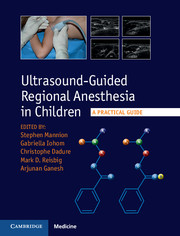Book contents
- Frontmatter
- Contents
- List of contributors
- 1 Introduction
- Section 1 Principles and practice
- Section 2 Upper limb
- 7 Ultrasound-guided axillary brachial plexus block
- 8 Ultrasound-guided supraclavicular brachial plexus block
- 9 Ultrasound-guided infraclavicular brachial plexus block
- 10 Ultrasound-guided interscalene brachial plexus block
- Section 3 Lower limb
- Section 4 Truncal blocks
- Section 5 Neuraxial blocks
- Section 6 Facial blocks
- Appendix: Muscle innervation, origin, insertion, and action
- Index
- References
10 - Ultrasound-guided interscalene brachial plexus block
from Section 2 - Upper limb
Published online by Cambridge University Press: 05 September 2015
- Frontmatter
- Contents
- List of contributors
- 1 Introduction
- Section 1 Principles and practice
- Section 2 Upper limb
- 7 Ultrasound-guided axillary brachial plexus block
- 8 Ultrasound-guided supraclavicular brachial plexus block
- 9 Ultrasound-guided infraclavicular brachial plexus block
- 10 Ultrasound-guided interscalene brachial plexus block
- Section 3 Lower limb
- Section 4 Truncal blocks
- Section 5 Neuraxial blocks
- Section 6 Facial blocks
- Appendix: Muscle innervation, origin, insertion, and action
- Index
- References
Summary
Clinical use
Regional anesthesia of the upper extremity can be achieved by placing local anesthetic (LA) at varying locations along the course of the brachial plexus. The brachial plexus begins just outside the intervertebral foramina at the lower cervical region from the ventral rami of C5–C8 and T1 spinal nerves. The C5 and C6 rami join to form the superior trunk at the lateral border of the middle scalene muscle; the C8 and T1 rami join to form the inferior trunk, and the C7 ramus continues as the middle trunk. These trunks lie between the anterior and middle scalene muscles and neural blockade at this site is termed the interscalene brachial plexus or interscalene block (ISB).
ISB has demonstrated efficacy in providing postoperative analgesia after shoulder and proximal humerus surgery. The use of ISB is associated with a reduction in post-operative pain scores, opioid requirements, and opioid-related side effects after shoulder surgery.
It is generally considered to be superior to the supraclavicular block for shoulder procedures as it provides coverage of the suprascapular nerve, which provides sensation to the shoulder joint.
The common complications of the ISB are Horner's syndrome (block of the cervical sympathetic chain leading to ptosis, miosis and anhidrosis on the ipsilateral side) and phrenic nerve block which can lead to shortness of breath. A rare but potentially devastating complication of the ISB is injury to the cervical spinal cord. The American Society of Regional Anesthesia (ASRA), in its guidelines for performing regional anesthesia for patients under general anesthesia, recommended that the ISB not be placed while a patient is under general anesthesia (Bernards et al., 2008). One of the reasons for this recommendation is the risk of spinal cord damage during an ISB secondary to the needle entry into the spinal canal (Benumof, 2000). A majority of the peripheral nerve blocks in pediatric patients are placed with the patient under general anesthesia (Gurnaney et al., 2014). In addition, placement of an ISB with a pediatric patient awake or under mild sedation carries the risk of patient movement during the procedure while the needle is in close proximity to important neurovascular structures in the neck.
- Type
- Chapter
- Information
- Ultrasound-Guided Regional Anesthesia in ChildrenA Practical Guide, pp. 79 - 84Publisher: Cambridge University PressPrint publication year: 2015



